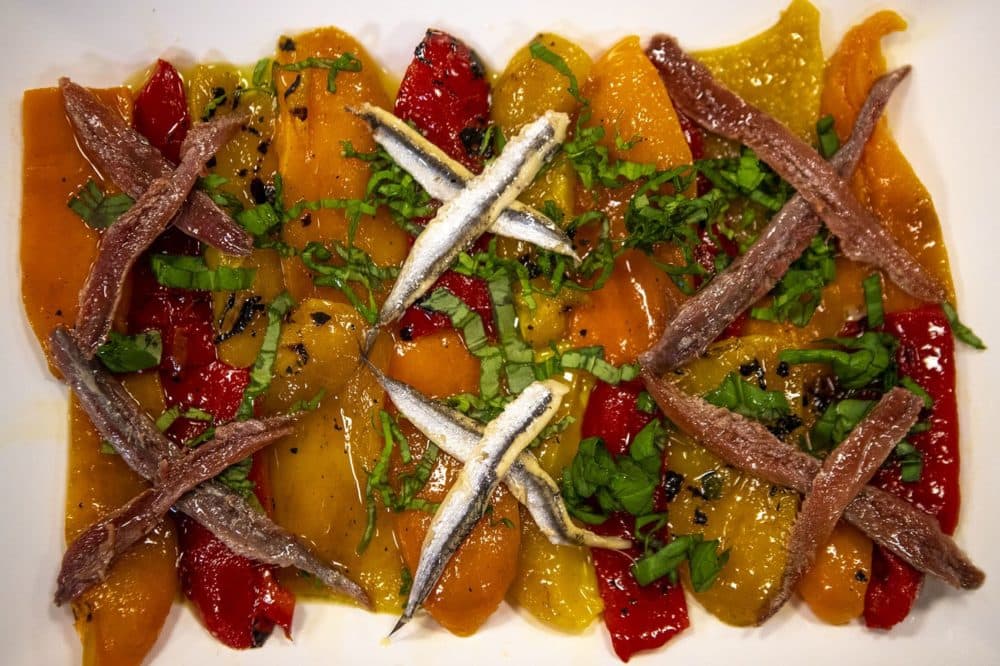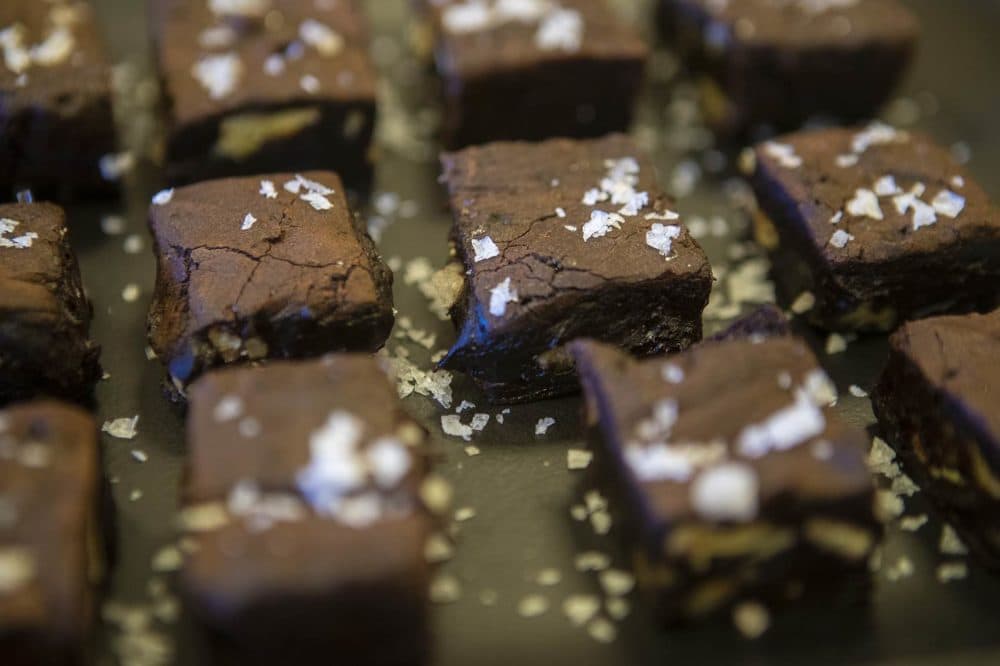Advertisement
What Chef Kathy Gunst Learned In The Kitchen In 2018
As we move toward 2019, Here & Now resident chef Kathy Gunst joins host Jeremy Hobson to talk about what she's learned in the kitchen that can help listeners, and share two recipes to help ring in the holidays.
I did a lot of cooking this year. A whole lot. And when I think back about some of the things that I learned in my kitchen in 2018, most of them have to do with intent, instinct, kitchen smarts and focus.
The idea for this segment started when I got a letter from a listener who was making my buttercrunch recipe. He wrote that he was distracted helping kids and did several things "wrong!" The buttercrunch came out just fine, but it got me thinking. People write me all year: "I made your cake but I only had 3 eggs, not 5!" And, "I made your sauce but I didn’t have any fresh herbs or dry," or, "I made your chicken dish but I used pork" — happens all the time.
So I say, be smart about substitutions! Think it through. Here are several tips:
- Read a recipe through thoroughly. You need to know ahead of time if a dough needs to sit for 3 hours before being rolled out. You need to know that the cake calls for dried cardamom and fresh cranberries. You need to know everything that's going to happen so you can plot out your time and not get stumped midway through making a casserole or cake.
- Mise en place is a French term meaning "putting in place," or, "everything in its place." This is what chefs and sous chefs do in professional kitchens: They get all their ingredients ready before they start cooking. The garlic is peeled and chopped and placed in a small bowl. The flour is sifted and measured and placed in another bowl. All the ingredients for a dish are measured out and placed in front of the cook. The beauty of being this prepared is that you’ll never get confused about what you have and have not added. You know that moment when you're baking a cake and you think, "Did I already add the baking soda? Oh, shoot, or was that the baking powder?" If you set up all your ingredients ahead of time you'll always know what you have and have not added. Plus you'll feel so professional and organized. That doesn't hurt, does it?
- Speaking of measuring, use a kitchen scale. Buy a small, inexpensive one — they will lend an accuracy to all your baking and cooking that might just blow your mind. A cup of flour carelessly measured is quite different than 8 ounces of flour measured out on a small kitchen scale. It means accuracy and that means far better results in all your cooking.
- Substitutions can be made in almost any recipe but you need to be smart about it. No, you cannot reduce 5 eggs to 2 eggs without the dish suffering. You can't substitute almond flour for wheat flour. It's a different ingredient and reacts differently in baked goods. You can't really change the proportion of dry ingredients or liquid when baking. There is a science to this. If you take a cupcake recipe and make a cake out of it it will take longer to bake. Don't rely on the recipe so much that you lose your common sense. But there are many substitutions that are easy and simple. For instance, you can substitute cinnamon for allspice, or rosemary for thyme. You can use turkey instead of chicken in a recipe without disastrous results — but turkey is drier so it may need more fat added. Think it through. Will your substitution change the science of the recipe? Or, are you simply swapping out one flavor for another?
- When cracking eggs for cake batters, omelets, sauces, etc., always crack them into a small bowl and simply slide the egg into the batter or skillet or mixer. This way if you crack the shell, it ends up in the bowl and not in your food. The easiest way to scoop out a stray piece of egg shell is to remove it with another piece of egg shell. Seriously — egg shell attracts egg shell. Use half a cracked egg shell to scoop out any bits of egg shell that may have broken into your bowl.
- Cook smart. If a recipe says bake for 30 minutes or until the edges of the cake or pie are golden brown and pulling away from the sides of the pan, listen to the words rather than the timing. If after 30 minutes your cake still looks raw, there's a good chance it is. Always follow the descriptor of what you should be looking for.
Advertisement

Umami Roasted Red Peppers With Anchovies And Basil
I love roasted red peppers. I love umami-rich anchovies. But the combination of the two is bigger than the sum of its parts. This is a great first course or appetizer for the holidays, served with crunchy, warm bread or crackers.
Serves 4.
Ingredients
- 1 large sweet red pepper
- 10 anchovy filets
- 6 whole leaves fresh basil, plus 2 tablespoons fresh basil cut into thin shreds
- 3 tablespoons olive oil
- Freshly ground pepper
Instructions
- Place the pepper directly on a high gas flame and cook, flipping it from side to side and top to bottom until the whole pepper is charred. If you don't have gas flame, heat a broiler and place the pepper on foil or a cookie tray and broil until charred on all sides. Immediately remove from flame or broiler and place in a clean paper bag and seal tightly. You want to steam the hot pepper so it will easily release its charred skin. Remove from bag after 5 minutes or so and peel off the charred skin and discard. Cut pepper in half and remove ribs and seeds. Cut the roasted pepper in thick strips.
- Arrange the pepper on a serving plate. Place the shredded basil on top and then criss-cross 2 anchovies into an "X" shape; repeat scattering them on top of all the peppers. Add the whole basil leaves and drizzle on the olive oil.

Best Cocoa Brownies
by Alice Medrich, from "Food52 Genius Desserts"
Most brownie recipes are remarkably consistent: melt chocolate with butter, then mix with sugar, eggs, and flour. They come together fast, and you are a happy clam.
But pastry chef Shuna Lydon told me about a recipe that changed her life by simply replacing the chocolate with cocoa powder. It did not surprise me to learn that the recipe belonged to Alice Medrich (you can thank her for popularizing chocolate truffles in America in the 1970s at her Berkeley shop, Cocolat).
"Alice knows chocolate. It speaks to her. We’re lucky to have her as a translator," Lydon wrote to me. Not only is cocoa less expensive than chocolate—a boon to pastry chefs, or anyone who makes a lot of brownies—but the fudgy bars that result are, counterintuitively, better.
By taking out the chocolate, with its variable fat and sugar, Medrich was able to control and fine-tune the proportions of both. When she added the fat back (in the form of butter), the centers stayed softer. With just the right amount of sugar, the crusts were shinier. Commit, as Medrich does, to stirring for forty strokes in step 3—the effort will give you a satisfying jump in heart rate and build structure in the very rich batter.
Makes 16 large or 25 small brownies
Ingredients
- 1/2 cup plus 2 tablespoons (140g) unsalted butter
- 1 1/4 cups (250g) sugar
- 3/4 cup plus 2 tablespoons (80g) unsweetened cocoa powder (see note)
- 1/4 teaspoon fine sea salt
- 1/2 teaspoon pure vanilla extract
- 2 large eggs, cold
- 1/2 cup (65g) all-purpose flour
- 2/3 cup (65g) walnut or pecan pieces (optional)
- Flaky salt, for garnish (optional)
Instructions
- Heat the oven to 325°F (165°C), with a rack in the lower third. Line an 8-inch (20cm) square baking pan with parchment paper, leaving a 1-inch (2.5cm) overhang on two opposite sides for easier lifting when the brownies are done.
- Combine the butter, sugar, cocoa powder, and salt in a metal bowl and set the bowl directly in gently simmering water in a wide skillet. Stir occasionally with a wooden spoon or rubber spatula, until the butter is melted and the mixture is hot enough that you want to remove your finger quickly after dipping it in. (It might look gritty here but don’t worry, it will smooth out later.) Remove the bowl from the skillet and let it cool briefly, until the mixture is only warm, not hot.
- Stir in the vanilla. Beat in the eggs, one at a time, stirring vigorously after each one. When the batter looks thick, shiny, and well mixed, add the flour, stir until no streaks of flour remain, and then beat vigorously for 40 strokes. It’s worth it! Fold in the nuts and scrape the batter into the pan, smoothing the top.
- Bake until a toothpick stuck in the center comes out slightly moist with batter, 20 to 25 minutes. Let cool completely in the pan on a rack.
- Lift up the overhanging ends of the parchment paper and transfer the brownies to a cutting board. Cut into 16 or 25 squares, then lift brownies off the parchment. (If you want really good, clean slices, freeze or refrigerate just until firm first.) Sprinkle with flaky salt just before serving. Store in an airtight container at room temperature.
Note: There are two types of unsweetened cocoa powder—natural or Dutch-processed. Either will work here, but they give you slightly different results. Natural cocoa makes brownies with a more complex flavor and, as Alice Medrich puts it, lots of tart, fruity notes. Dutch-processed cocoa powder makes a darker brownie with a mellower flavor, like old-fashioned chocolate pudding.
Reprinted with permission from Food52 Genius Desserts: 100 Recipes That Will Change the Way You Bake by Kristen Miglore, copyright © 2018. Published by Ten Speed Press, an imprint of Penguin Random House.
This segment aired on December 24, 2018.
